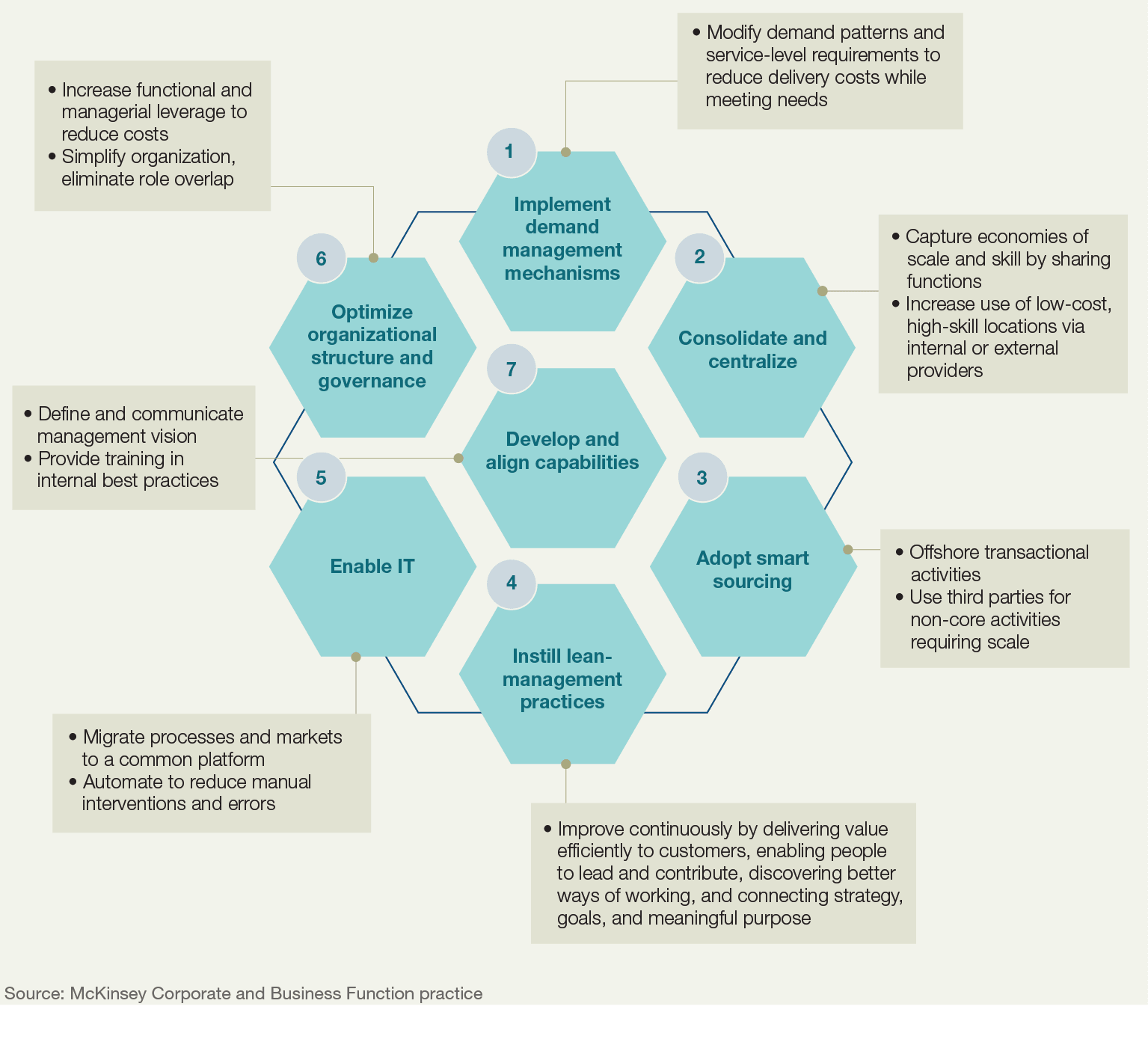This introduction to a seven-part series sets the stage for why business functions need a structured approach and leadership commitment to be both effective and efficient. Each of the seven levers that help embed healthy practices and sustain improvements—as well as bring tremendous value to the organization—are detailed in subsequent articles, which will be published over the course of 2014.
For all of the changes that corporate and business functions—everything from HR and legal to finance and IT—have undertaken over the past couple of decades, the basic truth remains that they have a hard time fighting for limited management attention. Individual functions occasionally find themselves under the microscope: leaders may ask HR to automate the initial review of resumes, or IT to restructure application development to take advantage of specialized external talent, for example. But much of the time, as long as functions aren’t causing obvious problems (especially from a cost perspective), leaders focus their attention on the parts of the business that directly generate revenues.
When problems do arise, too many organizations skip over the arduous business of finding the real sources of underperformance and designing thorough solutions. Instead, they may do little more than impose arbitrary, across-the-board cost targets while ordering the functions to “do more with less.” Whatever the resulting improvement, it often dissipates quickly, particularly if a function then finds itself short of needed capabilities.
Indeed, the point is reinforced by 20 years of S&P 500 data tracking member companies’ sales, general, and administrative (SG&A) expenses against revenues. During the period covered, advances in technology, offshoring, and related fields meant that SG&A costs fell for many organizations. But only some realized the full benefit. Members whose SG&A-to-revenue ratios started in the lowest quartile kept driving their costs down as a percentage of revenues. By contrast, those companies that started in the highest-cost quartile saw real “cost creep.” By the end of the period, they were in worse shape than ever, spending more than twice the share of their revenues on SG&A than their top-quartile peers (Exhibit 1).
Exhibit 1

Part of what makes better cost performance possible is the recognition that while support functions may not be sources of revenue, they often are underappreciated sources of value—in ways that reach well beyond short-term efficiency benefits. For example, as part of an end-to-end effort to turn orders more quickly into cash, one organization’s sales support, legal, and finance functions collaborated to standardize negotiation practices (including establishing standard contractual terms and conditions) and billing procedures. As a result, administrative costs per order fell by about half, and the billing-to-collection time dropped by three-quarters. Yet the most interesting effect was the value created on the front end: Sales productivity rose more than 30 percent. Sales executives, freed from seemingly endless internal meetings to align on a negotiating position for each deal, could instead concentrate on completing more deals.
Across an organization, these changes add up. One Fortune-50 multinational’s business support function transformation generated $2 billion in value over ten years, including $1.2 billion in acquisition synergies. But this type of result is possible only by broadening the central question—from maximizing efficiency alone to maximizing effectiveness as well.
That means making a commitment. Based on the experience of over 2,000 organizations worldwide that have transformed support functions over the last decade, we find that the organizations that sustain meaningful performance gains do so only by attacking on multiple fronts at once. Grouped together, these changes form seven interconnected levers (Exhibit 2):
- Implement demand management mechanisms to meet the needs of the business more accurately, reducing costs while increasing impact;
- Consolidate and centralize support services, capturing greater economies of scale and skill by sharing similar functions across regional and business boundaries;
- Adopt smart sourcing, such as moving transactional activities to more appropriate locations and relying on third-parties for non-core functions that operate better at a larger scale;
- Instill lean management disciplines, which together form a continuous improvement system in which organizations learn to deliver value more efficiently, enable people to lead and contribute more fully, discover better ways of working, and more closely connect strategy, goals, and meaningful purpose;
- Enable IT, migrating whole processes to common platforms across the enterprise and eliminating manual interventions and errors;
- Optimize organizational structure and governance, reducing organizational complexity, aligning decision making, and strengthening ownership, with clear and effective mechanisms for resolving controversies;
- Develop and align capabilities, reassessing skill levels and resetting role profiles as needed to ensure that the right talent is in the right positions in the organization.
Exhibit 2

Of course, based on their different starting points, organizations will naturally differ in the attention they give to each lever. But the most effective support-function transformations incorporate all seven to some degree. Accordingly, over the course of this series, we’ll consider each of the seven in turn.
About the authors: Dash Bibhudatta is an expert in McKinsey’s Chicago office, Jonathan Silver is a principal in the New York office, and Edward Woodcock is a senior expert in the Stamford office.